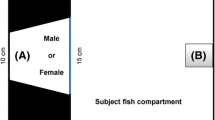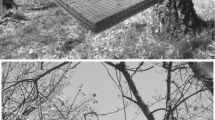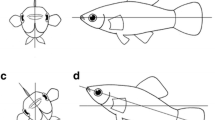Abstract
Female agonistic behaviour during pregnancy and lactation is common in several pinnipeds and has been associated to pup or territory defence. Previous studies on female agonistic behaviour in pinniped breeding groups have not usually considered the number of females per breeding group, which could influence the degree of aggressiveness. We compared female agonistic behaviour (open-mouth displays and bites) within two colonies with different breeding substrates (homogeneous, Punta Norte; heterogeneous, Pirámide) of South American sea lions using two methods: weighted means and general linear models. We found that both aggressive interaction rates were significantly affected by female density, which accounted for a greater proportion on the variability in bite rates than in open-mouth rates. Controlling for the number of females, we found with both methods that open-mouth rates were higher than bite rates within the Pirámide colony; however, no differences were found within the Punta Norte colony. In Pirámide, open-mouth rates could be used more often as threats to minimise the chances of more severe aggressions. The conclusion is that females vary their use of agonistic interactions in relation to their density in the colony with heterogeneous substrate, which may be related to the presence of limited numbers of tide pools that heightens competition for thermoregulatory resources.

Similar content being viewed by others
References
Anderson SS, Baker JR, Prime JH, Baird A (1977) Mortality in grey seal pups: incidences and causes. J Zool 189:407–417
Boness DJ, Bowen WD, Iverson SJ (1995) Does male harassment of females contribute to reproductive synchrony in the grey seal by affecting maternal performance? Behav Ecol Sociobiol 36:1–10
Boness DJ, Craig MP, Honigman L, Austin S (1998) Fostering behavior and the effect of female density in Hawaiian monk seals, Monachus schauinslandi. J Mammal 79:1060–1069
Bowen WD (1991) Behavioral ecology of pinniped neonates. In: Renouf D (ed) Behavior of pinnipeds. Chapman & Hall, London, pp 66–127
Bradbury JW, Vehrencamp SL (1998) Principles of animal communication. Sinauer, Sunderland
Bradshaw CJA, Davis LS, Lalas C, Harcourt RG (2000) Geographic and temporal variation in the condition of pups of the New Zealand fur seal (Arctocephalus forsteri): evidence for density dependence and differences in the marine environment. J Zool 252:41–51
Campagna C (1985) The breeding cycle of the southern sea lion, Otaria byronia. Mar Mamm Sci 1:210–218
Campagna C, Le Boeuf B (1988a) Thermoregulatory behaviour in the sea lion and its effect on the mating system. Behaviour 107:72–90
Campagna C, Le Boeuf B (1988b) Reproductive behaviour of southern sea lions. Behaviour 104:233–261
Campagna C, Le Boeuf B, Cappozzo HL (1988) Groups raids: a mating strategy of male Southern sea lions. Behaviour 105:224–249
Campagna C, Bisioli C, Quintana F, Perez F, Vila A (1992) Group breeding in sea lions: pups survive better in colonies. Anim Behav 43:541–548
Carey PW (1992) Agonistic behaviour in female New Zealand fur seals, Arctocephalus forsteri. Ethology 92:70–80
Carranza J, Valencia J (1999) Red deer females collect on male clumps at mating areas. Behav Ecol 10:525–532
Cassini MH (1985) Comportamiento social de las hembras adultas del Lobo Marino del Sur, Otaria byronia (Blainville, 1820) durante la temporada de cría. Rev Latinoam Psicol 17:339–350
Cassini MH (1999) The evolution of reproductive systems of pinnipeds. Behav Ecol 10:612–616
Cassini MH (2000) A model on female breeding dispersion and the reproductive systems of pinnipeds. Behav Processes 51:93–99
Cassini MH (2001) Aggression between females in the South American fur seal Arctocephalus australis. Mamm Rev 31:169–172
Cassini MH, Fernández-Juricic E (2003) Costs and benefits of joining South American sea lion breeding units: testing the assumptions of a model on female breeding dispersion. Can J Zool 81:1154–1160
Christenson TE, Le Boeuf BJ (1978) Aggression in the female northern elephant seal, Mirounga angustirostris. Behaviour 64:158–172
Clutton-Brock TH, Deutsch JC, Nefdt RJC (1993) The evolution of ungulate leks. Anim Behav 46:1121–1138
Doidge DW, Croxall JP, Baker JR (1984) Density-dependent pup mortality in the Antarctic fur seal Arctocephalus gazella at South Georgia. J Zool 202:449–460
Ebensperger LA (1998) Strategies and counterstrategies to infanticide in mammals. Biol Rev Camb Philos Soc 73:321–346
Fernández-Juricic E, Campagna C, Enriquez V, Ortiz CL (1999) Vocal communication and individual variation in breeding South American sea lions. Behaviour 136:495–517
Fernández-Juricic E, Campagna C, Enriquez V, Ortiz CL (2001) The effects of social contexts on South American sea lion male vocal rates. Mar Mamm Sci 17:387–396
Francis JM (1987) Interfemale aggression and spacing in the northern fur seal Callorhinus ursinus and the California sea lion Zalophus californianus. Ph.D. thesis, University of California, Santa Cruz
Fowler CW (1987) A review of density dependence in populations of large mammals. Curr Mammal 1:401–441
Freckleton RP (2002) On the misuse of residuals in ecology: regression of residuals vs. multiple regression. J Anim Ecol 71:542–545
Galimberti F, Boitani L, Marzetti I (2000) The frequency and costs of harassment in southern elephant seals. Ethol Ecol Evol 12:345–365
Gentry RL (1975) Comparative social behavior of eared seals. Rapp P-v Reun—Cons Int Explor Mer 169:164–189
Hamilton JE (1934) The Southern sea lion Otaria byronia (Blainville). Discov Rep 8:269–318
Harcourt R (1991) Maternal aggression in the South American fur seal in Peru. Can J Zool 70:320–325
Harcourt R (1992) Factors affecting early mortality in the South American fur seal (Arctocephalus australis) in Peru: density-related effects and predation. J Zool 226:259–270
Le Boeuf BJ, Briggs KT (1977) The cost of living in a seal harem. Mammalia 41:167–195
Le Boeuf BJ, Campagna C (1994) Protection and abuse of young in pinnipeds. In: Parmigiani S, vom Saal FS, Chur, R (eds) Infanticide and parental care. Academic, Harwood, pp 257–276
Maestripieri D (1992) Functional aspects of maternal aggression in mammals. Can J Zool 70:1069–1077
Majluf P (1992) Timing of births and juvenile mortality in the South American fur seal in Peru. J Zool 227:367–383
McCann TS (1982) Aggressive and maternal activities of female southern elephant seals (Mirounga leonina). Anim Behav 30:268–276
McCulloch CE, Searle SR (2001) Generalized, linear and mixed models. Wiley, New York
Miller EH (1974) Social behaviour between adult male and female New Zealand fur seals, Arctocephalus forsteri (Lesson) during the breeding season. Aust J Zool 22:155–173
Phillips AV (2003) Behavioral cues used in reunions between mother and pup south American fur seals (Arctocephalus australis). J Mammal 84:524–535
Phillips AV, Stirling I (2001) Vocal repertoire of South American fur seals, Arctocephalus australis: structure, function, and context. Can J Zool 79:420–437
Svare BB (1990) Maternal aggression: hormonal, genetic, and developmental determinants. In: Krasnegor NA, Bridges RS (eds) Mammalian parenting: biochemical, neurobiological, and behavioural determinants. Oxford Univ. Press, Oxford, pp 179–210
Trillmich F, Trillmich KGK (1984) Mating systems of pinnipeds and marine iguanas: convergent evolution of polygyny. Biol J Linn Soc 21:209–216
Twiss SD, Caudron A, Pomeroy PP, Thomas CJ, Mills JP (2000) Finescale topographical correlates of behavioural investment in offspring by female grey seals, Halichoerus grypus. Anim Behav 59:327–338
Twiss SD, Duck C, Pomeroy PP (2003) Grey seal (Halichoerus grypus) pup mortality not explained by local breeding density on North Rona, Scotland. J Zool (Lond) 259:83–91
Underwood AJ (1997) Experiments in ecology: their logical design and interpretation using analysis of variance. Cambridge Univ. Press, Cambridge
Vilá BL, Cassini MH (1990) Aggressiveness between females and mother–pup separation in the southern sea lion, in Chubut, Argentina. Rev Chil Hist Nat 63:169–176
Werner R, Campagna C (1995) Diving behavior of lactating southern sea lions in Patagonia. Can J Zool 73:1975–1982
Acknowledgements
We deeply thank Claudio Campagna for his feedback and fruitful discussions about the behavioural ecology of South American sea lions. EFJ was supported by the College of Natural Sciences and Mathematics, California State University Long Beach. MHC was funded by the Consejo Nacional de Investigaciones Cientificas y Tecnicas and the Agencia Nacional de Promoción Científica y Tecnológica. Behavioural observations complied with the current laws of the country in which they were performed.
Author information
Authors and Affiliations
Corresponding author
Additional information
Communicated by Marco Festa-Bianchet
Rights and permissions
About this article
Cite this article
Fernández-Juricic, E., Cassini, M.H. Intra-sexual female agonistic behaviour of the South American sea lion (Otaria flavescens) in two colonies with different breeding substrates. acta ethol 10, 23–28 (2007). https://doi.org/10.1007/s10211-006-0024-4
Received:
Revised:
Accepted:
Published:
Issue Date:
DOI: https://doi.org/10.1007/s10211-006-0024-4




